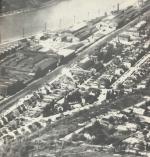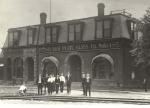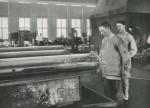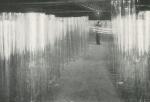![header=[Marker Text] body=[Among the largest and most productive plate glass factories in the world; opened 1887. At its peak, the plant employed more than 3,500 ethnically diverse workers, who passed through a specially-built tunnel under busy train tracks. Operations ended 1991.] sign](http://explorepahistory.com/kora/files/1/10/1-A-337-139-ExplorePAHistory-a0l2p9-a_450.jpg)
Mouse over for marker text
Name:
Pittsburgh Plate Glass Ford City Works
Region:
Pittsburgh Region
County:
Armstrong
Marker Location:
Third Ave. at Ninth St., Ford City
Dedication Date:
November 12, 2003
Behind the Marker
"Window shopping" was a new phrase that appeared in America in the first decade of the twentieth century. Urban merchants, especially those in the great department stores, had discovered the selling power of attractively displaying merchandise behind large panes of plate glass. By 1915 the United States was producing 60 million square feet of plate glass per year, half of the world's total production. In the next decade, production doubled, in part because of the large demand for glass in modern skyscrapers. For example, the seventy-story RCA building in New York's Rockefeller Center had six thousand exterior windows containing nearly twenty thousand panes of glass.
The nation's largest manufacturer of plate glass was the Pittsburgh Plate Glass Company, established in 1883 by John Baptiste Ford and John Pitcairn. Plate glass was different from other types of glass because instead of being blown it was poured and rolled into shape. Extensive grinding and polishing operations–reducing the plate to half its original thickness–made the product smooth and shiny, free of optical distortion. The founder of the American plate glass industry, Captain John B. Ford, was a remarkable entrepreneur.
Born in Kentucky in 1811, he became a saddle maker during the Mexican War. Displaying a restlessness that would characterize his career, he owned in succession a general store, a flour mill, a tin shop, and an iron foundry. During the Civil War he built and sold riverboats and operated a fleet of steamboats on the Ohio River. In 1869 he built a plate glass factory in the state of Indiana, but shut it down a few years later. After another failed attempt, Ford began to build a plant in the small town of Creighton, twenty miles up the Allegheny River from Pittsburgh. When he ran short of money, he teamed up with John Pitcairn, who was a division superintendent of the Pennsylvania Railroad.
Pitcairn had been buying up oil and gas properties in the area. Thus, he could also provide the most important resource needed to make glass, cheap energy in the form of natural gas. Glass was made in furnaces that melted together sand, limestone, and soda ash, all of which were available in the area. Because there were no skilled glass polishers in the United States, Ford had to hire one from Britain. Combining skill, raw materials, and capital, Ford started up the Creighton plant in 1883.
Leaving his interests there to his two sons, he moved two miles up river to Tarentum and proceeded to build another plant. Upon completion of this project, he moved still further upstream to build not only another plant but an entire community, incorporated in 1889 as Ford City. A few years later he and his sons sold out their interest in Pittsburgh Plate Glass because of a dispute with Pitcairn over the future direction of the company. At the age of eighty-two Ford moved to Michigan to head a chemical company he had founded several years earlier to supply soda ash and alkalis to PPG. One of his sons founded the Edward Ford Plate Glass Company of Toledo, Ohio, that would eventually take half of the plate glass business away from PPG. The remarkably energetic Ford died at the age of ninety-one in 1903.
By 1910 the PPG Ford City plant was the largest glass plate factory in the world covering twenty acres and employing over two thousand men. The total population of the town was almost five thousand, nearly half of whom were foreign born. Because most work in the plate glass factory was unskilled, the Ford City Works drew upon the same pool of southern and eastern European immigrant labor that was attracted to the steel mills of Pittsburgh. By 1913 Ford City churches served the Slovak, Polish, and Greek communities.
Plate glass played a critical role in the architecture of American stores and office buildings in the first decades of the twentieth century. At the same time, however, other rapidly growing industries needed glass. By 1930, the automobile industry had become PPG's largest customer; the company was a pioneer in safety glass. By that time PPG's paint business–it had diversified into paints in 1900–was actually larger than its glass business. In spite of the decline in importance of plate glass within PPG, the Ford City Works continued to operate until 1991.
The nation's largest manufacturer of plate glass was the Pittsburgh Plate Glass Company, established in 1883 by John Baptiste Ford and John Pitcairn. Plate glass was different from other types of glass because instead of being blown it was poured and rolled into shape. Extensive grinding and polishing operations–reducing the plate to half its original thickness–made the product smooth and shiny, free of optical distortion. The founder of the American plate glass industry, Captain John B. Ford, was a remarkable entrepreneur.
Born in Kentucky in 1811, he became a saddle maker during the Mexican War. Displaying a restlessness that would characterize his career, he owned in succession a general store, a flour mill, a tin shop, and an iron foundry. During the Civil War he built and sold riverboats and operated a fleet of steamboats on the Ohio River. In 1869 he built a plate glass factory in the state of Indiana, but shut it down a few years later. After another failed attempt, Ford began to build a plant in the small town of Creighton, twenty miles up the Allegheny River from Pittsburgh. When he ran short of money, he teamed up with John Pitcairn, who was a division superintendent of the Pennsylvania Railroad.
Pitcairn had been buying up oil and gas properties in the area. Thus, he could also provide the most important resource needed to make glass, cheap energy in the form of natural gas. Glass was made in furnaces that melted together sand, limestone, and soda ash, all of which were available in the area. Because there were no skilled glass polishers in the United States, Ford had to hire one from Britain. Combining skill, raw materials, and capital, Ford started up the Creighton plant in 1883.
Leaving his interests there to his two sons, he moved two miles up river to Tarentum and proceeded to build another plant. Upon completion of this project, he moved still further upstream to build not only another plant but an entire community, incorporated in 1889 as Ford City. A few years later he and his sons sold out their interest in Pittsburgh Plate Glass because of a dispute with Pitcairn over the future direction of the company. At the age of eighty-two Ford moved to Michigan to head a chemical company he had founded several years earlier to supply soda ash and alkalis to PPG. One of his sons founded the Edward Ford Plate Glass Company of Toledo, Ohio, that would eventually take half of the plate glass business away from PPG. The remarkably energetic Ford died at the age of ninety-one in 1903.
By 1910 the PPG Ford City plant was the largest glass plate factory in the world covering twenty acres and employing over two thousand men. The total population of the town was almost five thousand, nearly half of whom were foreign born. Because most work in the plate glass factory was unskilled, the Ford City Works drew upon the same pool of southern and eastern European immigrant labor that was attracted to the steel mills of Pittsburgh. By 1913 Ford City churches served the Slovak, Polish, and Greek communities.
Plate glass played a critical role in the architecture of American stores and office buildings in the first decades of the twentieth century. At the same time, however, other rapidly growing industries needed glass. By 1930, the automobile industry had become PPG's largest customer; the company was a pioneer in safety glass. By that time PPG's paint business–it had diversified into paints in 1900–was actually larger than its glass business. In spite of the decline in importance of plate glass within PPG, the Ford City Works continued to operate until 1991.









